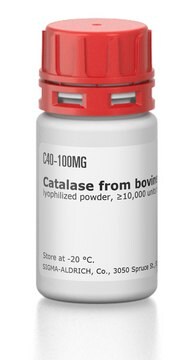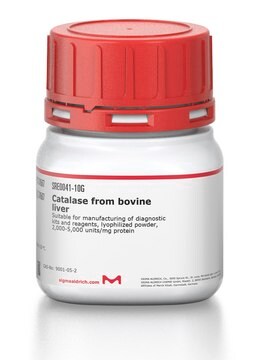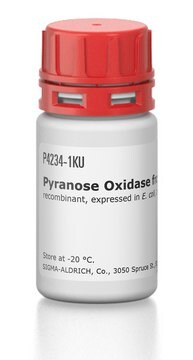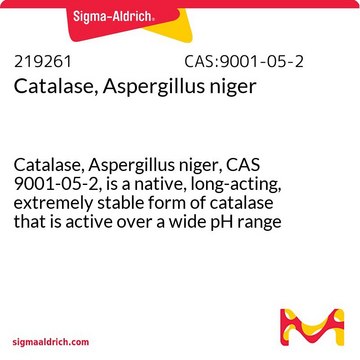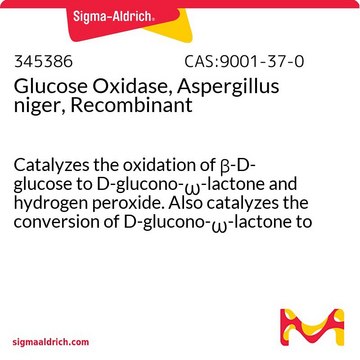C3155
Catalase from bovine liver
aqueous solution, ≥30,000 units/mg protein
Synonym(s):
H2O2:H2O2 oxidoreductase
About This Item
Recommended Products
biological source
bovine liver
Quality Level
description
optimum pH ~ 7.0
sterility
aseptically filled
form
aqueous solution
specific activity
≥30,000 units/mg protein
mol wt
tetramer ~250 kDa
contains
≤0.10 mg/mL Thymol
composition
ammonium sulphate, 30-50%
catalase, 10-20%
storage condition
(Tightly closed. Keep locked up or in an area accessible only to qualified or authorized
persons)
technique(s)
activity assay: suitable
isoelectric point
5.4
pI
5.4
UniProt accession no.
shipped in
wet ice
storage temp.
2-8°C
InChI
1S/C9H10O3/c1-2-12-9(11)7-3-5-8(10)6-4-7/h3-6,10H,2H2,1H3
InChI key
NUVBSKCKDOMJSU-UHFFFAOYSA-N
Gene Information
cow ... CAT(280743)
Looking for similar products? Visit Product Comparison Guide
General description
Catalase from bovine liver is a tetramer consisting of 4 equal subunits each with a 60 kDa molecular weight. Each of these subunits contains iron bound to a protoheme IX group. The enzyme will also strongly bind to NADP, where NADP and the heme group are within 13.7 angstroms.
Catalase from bovine is a tetrameric enzyme, consisting of four identical sub-units containing a single heme moiety per subunit. Each subunit has four domains like the α-helical domain, an eight-stranded β-barrel, N-terminal threading arm that is connected to the β-barrel via a wrapping loop.
Application
- as a component of the GLOX buffer during single molecule fluorescent in situ hybridization (smFISH) on primary mouse cortical neurons
- for its structural and kinetic analysis of its interaction with nitric oxide
- in the preparation of glucose oxidase-catalase system (GOX-CAT system) to generate H2O2 and study the effect of H2O2-induced oxidative stress on myelination in mouse organotypic cerebellar slice cultures
Catalase from bovine liver may be used:
- to prepare H2O2-O2 based biocathode for applications in glucose biofuel cells
- to study the kinetic properties and storage stability of catalase immobilized on to florisil
- in glutathione-mediated superoxide generation in an aqueous solution
Biochem/physiol Actions
Caution
Unit Definition
Preparation Note
inhibitor
Signal Word
Danger
Hazard Statements
Precautionary Statements
Hazard Classifications
Resp. Sens. 1
Storage Class Code
12 - Non Combustible Liquids
WGK
WGK 1
Flash Point(F)
Not applicable
Flash Point(C)
Not applicable
Personal Protective Equipment
Certificates of Analysis (COA)
Search for Certificates of Analysis (COA) by entering the products Lot/Batch Number. Lot and Batch Numbers can be found on a product’s label following the words ‘Lot’ or ‘Batch’.
Already Own This Product?
Find documentation for the products that you have recently purchased in the Document Library.
Customers Also Viewed
Our team of scientists has experience in all areas of research including Life Science, Material Science, Chemical Synthesis, Chromatography, Analytical and many others.
Contact Technical Service




